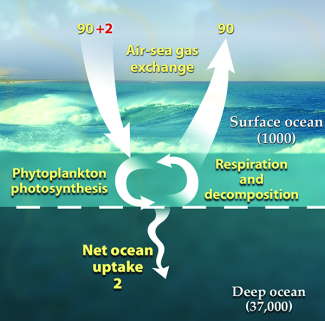The amount of dissolved carbon in the world's oceans is roughly equivalent, and likely greater, than atmospheric concentrations of CO2. Some of it gets semi-permanently sequestered, some gets released up into the atmospheric in a process that has been in place for millions of years. But with the global carbon picture changing, understanding the details of these processes has become more urgent: the slightest changes in ocean temperature or acidification (not hypothetical: we know these conditions are in flux) could usher in major changes in the relationship between the carbon in the atmosphere and in the ocean. Recently published research by UGA marine scientists reveals some important components in the marine carbon cycle:
The study, published in the Proceedings of the National Academy of Sciences in December, describes the cryptic currency of carbon cycling with new details on microbial food web processes.
Though atmospheric carbon receives the lion's share of attention from climate scientists, an equal if not greater amount of carbon exists in surface ocean water. Pooled as organic matter that both removes carbon dioxide from the atmosphere when it is formed and transfers it back when it's degraded, the mechanisms behind what happens to this carbon in the surface ocean have been poorly understood.
"Our paper shows that we may not be looking at the right compounds, or at least all of the right ones, when we work to understand how organic material is processed in the marine carbon cycle," said study co-author Mary Ann Moran, a Distinguished Research Professor in the UGA Franklin College of Arts and Sciences department of marine sciences.
"We found two compounds that had not been considered before, yet may be among the most important compounds being transferred from phytoplankton to dissolved organic matter, then recycled by bacteria."
Read the whole thing, but especially between the lines. As with any subject, a great deal of study is required just to be aware of leading-edge developments. I speak with scientists frequently, from a range of various fields, and [at least] one thing is becoming clear: scientific research is fast approaching a series of 'hyperspace' moments, where advances in particular fields, coupled with advances in technology and especially data management, will begin to allow significant cognitive leaps in our understanding of the physical world, including the human body and cosmology. To consider another recent example, the discovery of the mass of the Higgs boson at CERN LHC. It was a truly stunning feat, and these advances will continue to work in concert and build on each other, along with expanding data capabilities, to produce a clearer picture of our world - and hopefully provide new and better guidelines on how we might manage it better. And we need all the help we can get.
#pollyannameetsmurphyinadarkalley
Image: diagram showing a simplified representation of the Earth's annual carbon cycle, U.S. Department of Energy via wikimedia commons.

